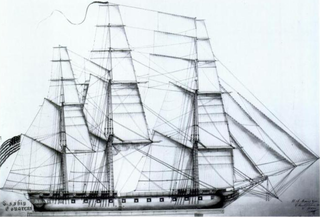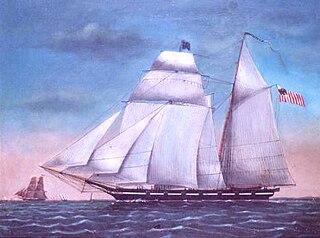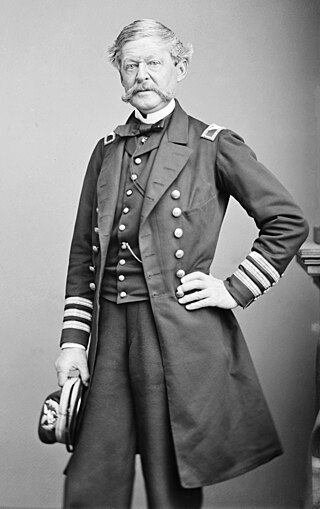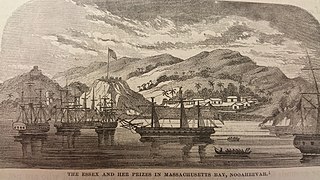
The first Vandalia was an 18-gun sloop-of-war in the United States Navy during the Second Seminole War and the American Civil War. She was named for the city of Vandalia, Illinois.

The Pacific Squadron was part of the United States Navy squadron stationed in the Pacific Ocean in the 19th and early 20th centuries. Initially with no United States ports in the Pacific, they operated out of storeships which provided naval supplies and purchased food and obtained water from local ports of call in the Hawaiian Islands and towns on the Pacific Coast. Throughout the history of the Pacific Squadron, American ships fought against several enemies. Over one-half of the United States Navy would be sent to join the Pacific Squadron during the Mexican–American War. During the American Civil War, the squadron was reduced in size when its vessels were reassigned to Atlantic duty. When the Civil War was over, the squadron was reinforced again until being disbanded just after the turn of the 20th century.

The United States Exploring Expedition of 1838–1842 was an exploring and surveying expedition of the Pacific Ocean and surrounding lands conducted by the United States. The original appointed commanding officer was Commodore Thomas ap Catesby Jones. Funding for the original expedition was requested by President John Quincy Adams in 1828; however, Congress would not implement funding until eight years later. In May 1836, the oceanic exploration voyage was finally authorized by Congress and created by President Andrew Jackson.
The Battle of Longwoods took place during the Anglo-American War of 1812. On 4 March 1814, a mounted American raiding party defeated an attempt by British regulars, volunteers from the Canadian militia and Native Americans to intercept them near Wardsville, in present-day Southwest Middlesex, Ontario.

The first three-quarters of the 19th century were marked by tribal warfare, incursions from neighbouring Tonga, and the increasing encroachment of foreign powers. This period also saw the rise of a warlord by the name of Seru Epenisa Cakobau, who forged the first nation-state covering all of modern Fiji in 1871, before ceding it to the United Kingdom in 1874.

The Battle of Mackinac Island was a British victory in the War of 1812. Before the war, Fort Mackinac had been an important American trading post in the straits between Lake Michigan and Lake Huron. It was important for its influence and control over the Native American tribes in the area, which was sometimes referred to in historical documents as "Michilimackinac".

The Second Samoan Civil War was a conflict that reached a head in 1898 when Germany, the United Kingdom, and the United States were locked in dispute over who should have control over the Samoan island chain, located in the South Pacific Ocean.
The series of Engagements on Lake Huron left the British in control of the lake and their Native American allies in control of the Old Northwest for the latter stages of the War of 1812.

A naval brigade is a body of sailors serving in a ground combat role to augment land forces.

The Formosa Expedition, or the Taiwan Expedition of 1867, was a punitive expedition launched by the United States against the Paiwan, an indigenous Taiwanese tribe. The expedition was undertaken in retaliation for the Rover incident, in which the Rover, an American bark, was wrecked and its crew massacred by Paiwan warriors in March 1867. A United States Navy and Marine company landed in southern Taiwan and attempted to advance into the Paiwan village. The Paiwan responded with guerrilla warfare, repeatedly ambushing, skirmishing, disengaging and retreating. Eventually, the Marines' commander was killed and they retreated to their ship due to fatigue and heat exhaustion, and the Paiwan dispersed and retreated into the jungle. The action is regarded as an American failure.

The West Indies Squadron, or the West Indies Station, was a United States Navy squadron that operated in the West Indies in the early nineteenth century. It was formed due to the need to suppress piracy in the Caribbean Sea, the Antilles and the Gulf of Mexico region of the Atlantic Ocean. This unit later engaged in the Second Seminole War until being combined with the Home Squadron in 1842. From 1822 to 1826 the squadron was based out of Saint Thomas Island until the Pensacola Naval Yard was constructed.

The siege of Apia, or the battle of Apia, occurred during the Second Samoan Civil War in March 1899 at Apia. Samoan forces loyal to Malietoa Tanumafili I were besieged by a larger force of Samoan rebels loyal to Mata'afa Iosefo. Supporting Malietoa were landing parties from four British and American warships. Over the course of several days of fighting, the Samoan rebels were defeated.

The United States Revenue Cutter Washington, named for Founding Father and the first U.S. president George Washington, was one of the 13 cutters of the Morris-Taney class. These cutters were the backbone of the United States Revenue Cutter Service for more than a decade. Samuel Humphreys designed these cutters for roles as diverse as fighting pirates, privateers, combating smugglers and operating with naval forces. He designed the vessels on a naval schooner concept. They had Baltimore Clipper lines. The vessels built by Webb and Allen, designed by Isaac Webb, resembled Humphreys' but had one less port.

Cadwalader Ringgold was an officer in the United States Navy who served in the United States Exploring Expedition, later headed an expedition to the Northwest and, after initially retiring, returned to service during the Civil War.

The first Fiji expedition undertaken by the United States occurred in October 1855 during the civil war on the islands. In response to the alleged arson attacks on the American commercial agent in Lautoka, Viti Levu, the navy sent a warship to demand compensation for the attack from Seru Epenisa Cakobau, the Vunivalu of Bau and self-proclaimed Tui Viti.

The Nuku Hiva Campaign was an armed conflict between the United States and the Polynesian inhabitants of Nuku Hiva during the War of 1812. It occurred in 1813, following Captain David Porter's decision to sail his fleet to the island for repairs before continuing his raid against British shipping. Upon arrival, the Americans became involved in a tribal war and allied themselves with the Te I'i people against the Happah and Tai Pi clans.

The Ivory Coast expedition, or the Liberia expedition, was a naval operation in 1842, launched by the United States against the West African Bereby people. After the attacks on the merchant ships Mary Carver and Edward Barley, the American Congress approved a punitive expedition to the area and placed Commodore Matthew C. Perry in command. The expedition was successful in exacting redress by destroying the fortified town of Little Bereby and by killing the chief responsible for the attacks on American shipping.

The Battle of Drummond's Island was a conflict between the United States Exploring Expedition and the village of Utiroa on April 1841 at Drummond's Island, Tabiteuea North, which is now part of Tabiteuea. The cause of the conflict was the disappearance of the American seaman John Anderson, who was suspected, with no evidence, to have been murdered by the village natives. In retaliation, the members of the expedition killed twelve of the natives and burned the village of Utiroa to the ground.

The Bombardment of Upolu, in 1841, was the second engagement with islanders of the Pacific Ocean during the United States Exploring Expedition.

Charles Henry Bromedge Caldwell (1823–1877) was a United States Navy officer during the American Civil War.



















